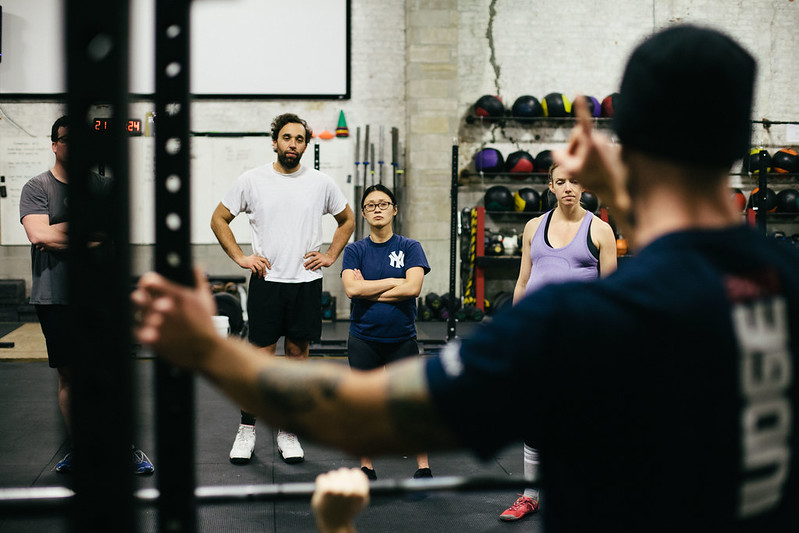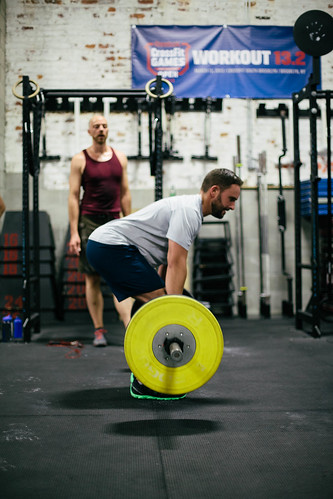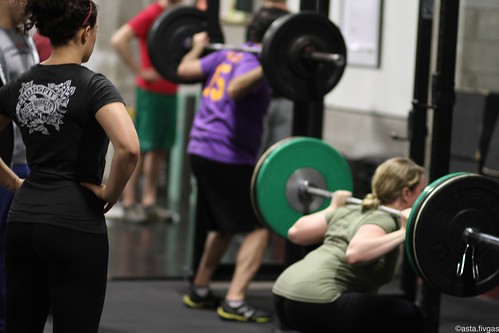Organizing Lifting Segments
 Monday, December 16, 2013 at 12:00AM
Monday, December 16, 2013 at 12:00AM 
As discussed in the article “Using Time Stamps to Manage Group Classes,” different types of training segments may require drastically different approaches. In this article, I'll talk about how CFSBK organizes and manages lifting segments—the portions of class when athletes are lifting semi-autonomously or in small groups. During these sections of class, our coaches walk around triaging issues on a case-by-case basis. Because you can't work with everyone at once, you'll need some tools to ensure these segments run smoothly and that people are training in an intelligent and safe manner.
White Board Review
Before breaking out into more autonomously organized training, the group should be briefed on the expectations of the lifting segment, including both the sets and reps, and the context of these movements within a larger training cycle. Having a clear context provides members with the tools to make better daily training decisions for themselves, prolongs their training progress, keeps them safer, and makes your job easier. (Even if your gym doesn’t schedule lifts and WODs within cycles as we do at CFSBK, you should still be able to explain how your athletes should approach their training each day.)
Splitting Up Assigned Stations Dr. Fidler and Daniel warming up deadlifts together.
Dr. Fidler and Daniel warming up deadlifts together.
If you simply tell your classes, "Okay, pair up and find a station," you immediately create an uncertain situation for the class and end up significantly decreasing the efficiency of the entire lifting segment. A few regulars will team up together, dude #1 squatting 135lbs will end up paired with dude #2 who plans on hitting 275lb (simply because they were standing next to each other), and a woman fresh out of Foundations will just stand there nervously and not say anything as she tries to read the cues of the group and guestimates her next move. People sharing stations despite having drastically different work weights leads to extra loading and unloading of plates. Additionally, novice lifters may try to keep up with their partner, causing them to make jumps that are inappropriate based on their current strength and skill. It's chaos like this that throws my brain into an OCD meltdown.
Taking a couple minutes to pair the group by intended weight ranges and assigning specific stations makes class management much easier and creates complementary training situations for your athletes. Your members will appreciate the regularity and organization. When CFSBK members travel to other affiliates, they often post their experiences to the Comments section of our blog, or will approach me to tell me about the affiliate and their experience working out there. They often have wonderful times learning from other coaches and meeting new athletes, but they consistently mention that many affiliates don’t provide much direction regarding who (if anyone) they were supposed to lift with or say how much time they have to complete lifts.
So, depending on the day's lift, pick weight ranges that cover an average heavy hitter to a 90lb newbie fresh out of Foundations. The athletes lifting the most weight in your class tend to be outliers and should be paired up first, then as you work down the ladder of intended work weights, you keep pairing people off to racks or barbells. Occasionally, you'll have to make an exception for people of significantly different heights if lifting is happening out of a rack. Check out this video below to see an example from one of our classes.
An experienced coach is usually one step ahead of the game and before even getting to the white board, knows generally how many pairings there will be based on total class size and the amount of equipment and space available. (This is also where “Starting Class with Introductions” can come in handy; you can count the class size during that segment and get a sense then of the pairings.)
Coaching Flow
At CFSBK, we expect the coach or coaches working each class to provide some constructive feedback to each person in the class. Even if someone is performing the movements beautifully, the coach should let them know and encourage more of the same. New people and troubled movers need the most general feedback to remain safe and build their awareness of how to approach warm-ups and work sets, so prioritize attending to them.
If the class is really big, say 25 or more people, I prefer to split coaches up spatially. One coach will oversee the four racks on one side of our gym while the other coach oversees the five racks along the far wall. It’s easier for coaches to manage smaller groups of people, and better enables them to provide consistent feedback. While there are certainly benefits to different coaching perspectives and coaches should collaborate, it's often better for a trainee to receive more consistent feedback from the same coach during a single class.  Courtney and Jessica trade between lifting and observing during training
Courtney and Jessica trade between lifting and observing during training
Lifting Culture
Part of running a mature gym involves arriving at the point where your intermediate and advanced members know how to weight train properly, both regarding basic technique and employing safe and constructive habits. They've been taught the essentials, including how to warm-up properly and practice good time management for the segment, along with a million other things such as spotting, how to take the bar out of the rack, when to pull back on weight, how to listen to their bodies, and even how to help newer athletes with some basics of both the movements and the flow of classes. This culture rubs off on your newer members and in the long run, creates a much more predictable and safe environment inside the gym.
__________________________
What are other ways to organize lifting segments?

Reader Comments (6)
Loving these posts. I've been segmenting my sessions since Day one, but having a timed, more structured approach definitely allows more work to be squeezed in. I think it's important to mix the group up for lifting segments, as this is often when the group get the most opportunity to interact with new people. Thanks for this blog David - very useful tips for newer Affiliate owners like myself!
Thanks for the feedback, Matt! Please share it with your friends and keep posting. I love to hear how other affiliate owners operate their gyms.
We recently switched over to having the entire class do the same strength lifts. It was getting too chaotic with individualized lifts. Since then, our classes have much great flow, there's better coaching, more learning, better movement.
We always review the movement(s) beforehand and go over all the points of performance. We review reps and sets, where to start and end for weights. At our gym, we have 5 racks in a line, so we "generally assign" people from heaviest to lightest (so new people go to the back, while veterans move to the front). It's been 3 months doing this and we've heard nothing but positive feedback.
Great article David. Thank you for this blog. It is a great resource and very helpful. Its greatly appreciated.
Thanks for the comments guys! Happy to hear you're enjoying the site.
Great post DO.